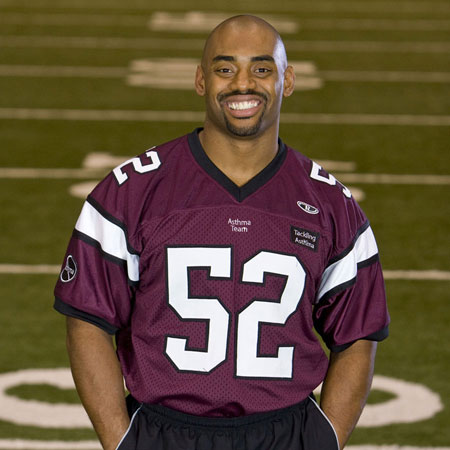Asthma Doesn't Have to Slow Youth Athletes

Heading into the 11th season of his career, St. Louis Rams middle linebacker Chris Draft has faced many formidable opponents on the field. But when he's not lining up against some of the NFL's best offensive playmakers, Draft battles another opponent off the field every day of his life.
Draft suffers from asthma, an inflammatory disease that affects the lungs, and has had to manage his health ever since his playing days at Stanford. Although asthma can usually be controlled once diagnosed, it may be more common than one might think. According to the Centers for Disease Control and Prevention (CDC), nearly 22.9 million people living in the United States have asthma - with 6.7 million suffers under the age of 18.
Dr. David Callahan, Captain in the U.S. Public Health Service, said when it comes to youth athletes, parents and coaches need to educate themselves on how to handle the situation when an asthma attack strikes.
"If I had to pick two things for a coach to know, know which of your kids have asthma, and know what to do in an asthma emergency," Dr. Callahan said. "Make sure that the kids with asthma have an asthma action plan from their physician.
"Parents of youth athletes should be working with their family physician to make sure that their asthma is well controlled and that they have both the appropriate controller medication and the appropriate rescue medication."
Asthma causes repeated episodes of wheezing, breathlessness, chest tightness, and nighttime or early morning coughing. Asthma is not curable, but attacks should only occur when a "trigger" bothers the lungs.
"Exercise itself can do it because of the increased rate of breathing, cold weather, cold air can be a trigger," Dr. Callahan said. "Pollen also is a very common one and is at its peaks in the spring for trees and in the fall for ragweed. Something else to look for is air pollution."
Because this disease affects nearly 9 percent of all children, the Minnesota Department of Health Asthma Program (MDH) and the Utah Department of Health Asthma Program (UDOH) collaborated together to educate others on the disease through "Winning with Asthma." A private-public partnership created by the National Lt. Governor's Association and funded by the CDC, the "Winning with Asthma" campaign features a Coach's Asthma Clipboard Program, which Draft has signed on with as the National Spokesman.
This issue has always been something Draft said is near and dear to him, and he hopes his example will encourage others to not let asthma interfere with following their dreams.
"It is controllable," Draft said. "With the right attention and understanding of what asthma is, you can play and enjoy playing football. You can't ignore it - it's like football in a way.
"If a player is struggling on the field, you don't ignore your stumbling block. You face it. You study it. You take it on. The "Winning with Asthma" program helps people get to that point."
The Coach's Asthma Clipboard Program is designed to help coaches learn about asthma, how it affects an athlete's ability to compete and how coaches can help their athletes manage their symptoms while performing at their very best.
Dr. Callahan recommends these steps to follow when an asthma attack occurs:
"First of all, the athlete should tell the coach immediately, stop the activity that he's doing, and immediately be given a rescue medication - usually Albuterol - with an inhaler or a nebulizer."
And in the event that the asthma attack appears to be severe, it's better to be safe than sorry.
"If it's a severe attack - if the athlete's lips or nails are blue, or has difficulty talking, walking or drinking liquids - that's an indication to call 9-1-1 right away," Dr. Callahan said. "The other very good reason to call 9-1-1 is if the coach or child is simply unsure what to do. It's never wrong to call, and minutes do count when things get severe."
Dr. Callahan said one precaution those with asthma should take this fall involves a new vaccine. The 2009 H1N1influenza vaccine is in production and early testing now and should be available in early October.
"We recommend that for seasonal flu, all children with asthma get a flu shot, and this year, all persons with asthma should get a seasonal flu shot and also the H1N1 flu vaccine," he said. "This is a new virus meaning it has not circulated before in the population, so because of that, there is very little immunity to it."
He also encourages youth football coaches to look at the "Winning with Asthma" program online to learn more about how to help improve the experience for youth athletes.
"Our expectation for asthma is that youth athletes should be able to take part in activities without feeling restricted," Dr. Callahan said. "They should be as much a member - and as good a member - of the team as children without asthma."

